
Soil consistency is one of the physical properties of the soil. It is a term used to describe the resistance of soil to mechanical stress or manipulation at various moisture contents. The soil particles are held together by strong force of cohension and adhension at various soil moisture content level to make the soil resistant to deformation and rupture. It also involves the behaviour of the soil towards gravity, pressure, thrust and pull, tendency to adhere to foreign bodies and the sensations which are evidenced (by the fingers of the observer) as feel”.
Soil consistency can be evaluated based on rupture, resistance and stickiness. Consistency largely depend on soil minerals and moisture content.
DESCRIPTION OF SOIL CONSISTENCY AT VARYING MOISTURE LEVEL
Soil consistence is described at three moisture levels namely ‘wet’, ‘moist’ and ‘dry’. Soil samples at this moisture levels can be used to measure soil consistency.
1. WET SOILS: For wet soils, it is expressed as both stickiness and plasticity.
STICKINESS: Soil Stickiness is the ability of the soil to adhere to other materials. Soil stickiness provides an estimate of the maximum water content at which normal soils will scour during tillage. At this moisture content, the soil shows maximum adherence between the thumb and the forefinger.
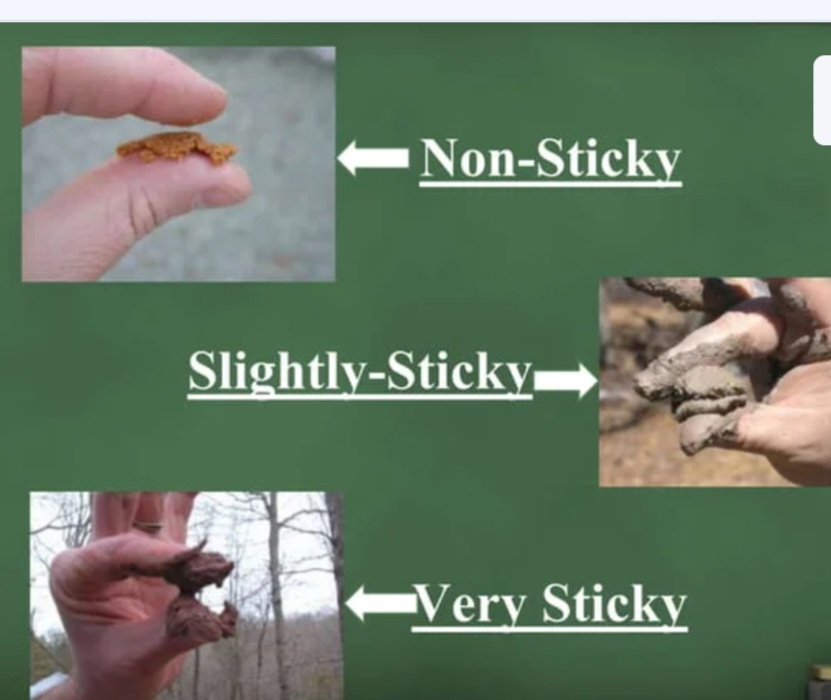
CLASSES OF SOIL STICKINESS
Stickiness is grouped into four categories namely
i) non sticky,
ii) slightly sticky,
iii) sticky and
iv) very sticky.
i. NON STICKY: The soil does not adhere or little amount adhere to the finger after release of pressure
ii. SLIGHTLY STICKY: The soil adhere to both fingers after release of pressure with little stretching on separation of fingers
iii. STICKY: The soil adhere to both fingers after release of pressure with some stretching on separation of fingers. It is also refered to as moderately sticky.
iv. VERY STICKY: The soil adhere firmly to both fingers after release of pressure with the soil stretches greatly on separation of fingers.
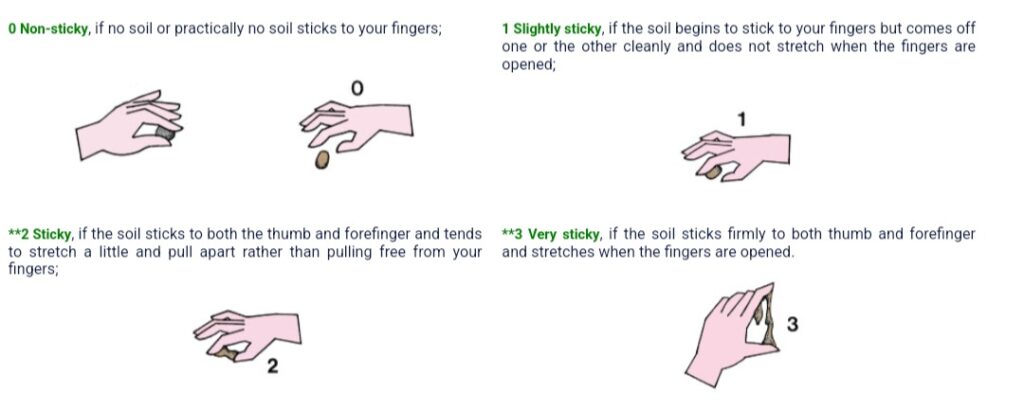
PLASTICITY: Plasticity of a soil is the degree at which the soil can be molded (to change its shape depending on stress) and retain the shape even when the stress is removed without rupture.
The ability of soil to mold depend on the percentage of silt, clay and moisture content in the soil. For example, soils containing more than 15% clay exhibit plasticity – pliability and the capacity of being molded.
PROPERTIES OF PLASTICITY
Plasticity properties describe the response of soil to change in moisture content.
a. The strength decreases as water content increases.
b. Soils swells up when water content increases.
c. Fine grained soils at very high moisture content possess properties similar to liquids
d. As the moisture is reduced, the volume of the soil decreases and the soil becomes plastic
e. If the moisture content is further reduced, the soil becomes semi solid when the volume does not change.
CLASSES OF PLASTICITY
There are degrees in plasticity namely:
i) non plastic,
ii) slightly plastic,
iii) plastic and
iv) very plastic
Plasticity can be evaluated when the soil form a 4cm long wire at water content where maximum plasticity is expressed.
i. NON PLASTIC: The soil will not form a 6mm diameter, 4cm long wire, or if formed, cannot support itself if held on one end
ii. SLIGHTLY PLASTIC: The soil will form a 6mm diameter, 4cm long wire, wire support itself, 4mm diameter, 4cm long wire, wire does not support itself.
iii. PLASTIC: The soil will form a 4mm diameter, 4cm long wire, will support itself, 2mm diameter, 4cm long wire , wire does not support itself.
iv. VERY PLASTIC: 2mm diameter, 4cm long wire , wire will support itself.
2. MOIST SOILS:
Moist soil with least coherence like clay, silt soil and soils high in organic matter adhere very strongly and resists crushing between the thumb and forefinger.
CLASSIFICATION OF MOIST SOILS
The different categories of moist soils are:
i. Loose-non coherent,
ii. Very friable – coherent, but very easily crushed,
iii. Friable – easily crushed,
iv. Firm – crushable with moderate pressure,
v. Very firm – crushable only under strong pressure and
vi. Extremely firm – completely resistant to crushing. (type and amount of clay and humus influence this consistency)
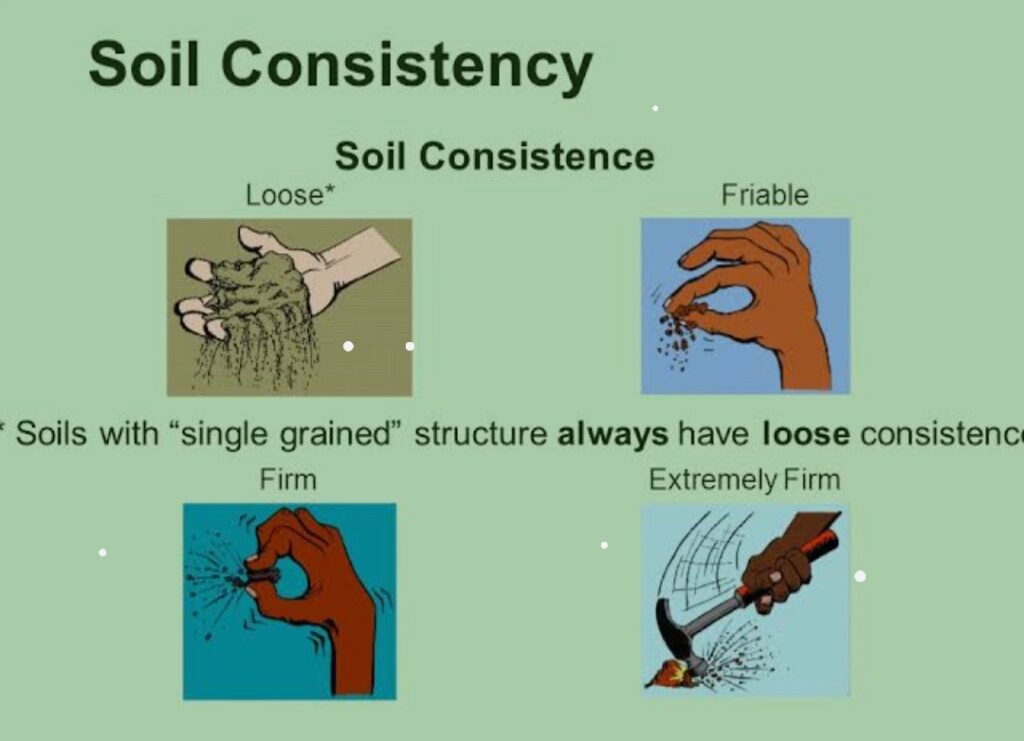
3. DRY SOILS:
In dry soil, the degree of resistance is related to the attraction of particles for each other.
CLASSES OF DRY SOILS
The different categories are
a. Loose – non coherent
b. Soft – The soil breaks when slight pressure is applied to it and turns to powder
c. Slightly hard – The soil breaks under moderate pressure
d. Hard – It becomes hard to break the soil with difficulty with pressure
e. Very hard – The soil is resistant to pressure
f. Extremely hard – extreme resistance of the soil to break with pressure and cannot be broken.
ATTERBERG’S LIMITS OF SOIL CONSISTENCY Atterberg’s Limits was discovered by a Swedish agricultural engineer called Albert Atterberg. Atterberg limit are the limit of moisture content used to define soil behaviour. Soil can behave in various ways under the following conditions: viscous liquid state, plastic state, semi solid state, and solid state. As the moisture content increases, the conditions become weaker from solid state to the viscous liquid state respectively. Inbetween these states are various limits. For example, between the viscous solid state and the plastic state is the liquid limit, denoted by LL. Between the plastic state and semi solid state is the plastic limit (PL), and between the semi solid state and the solid state is the shrinkage limit and lastly at the below the solid state is the dry limit.
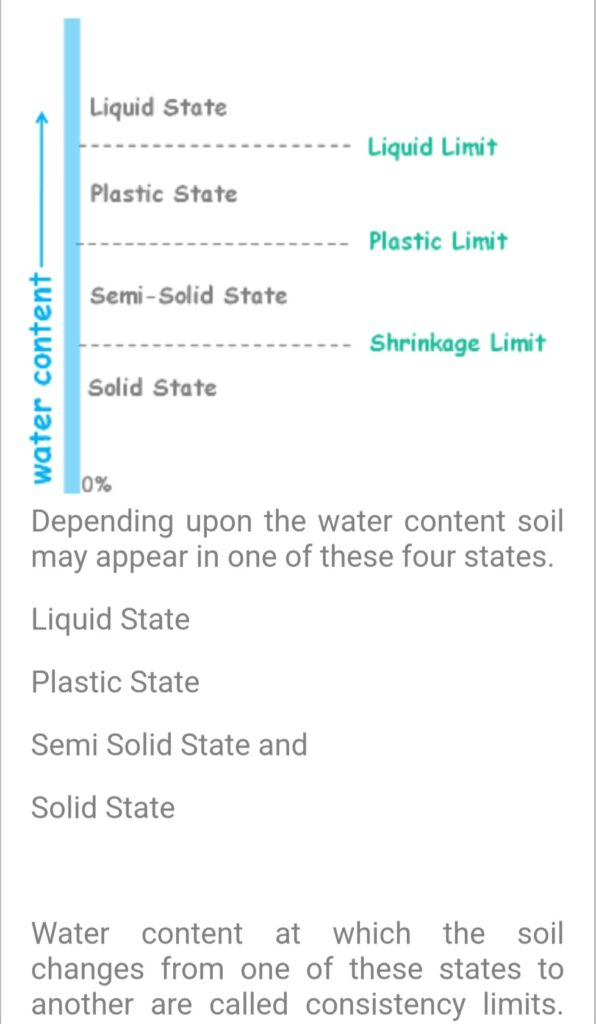
a. LIQUID LIMIT (LL): This is the moisture content at which soil begin to behave as a liquid material and begins to flow. Normally below 100.
b. PLASTIC LIMIT (PL): This is the moisture content at which soils begin to behave as a plastic material. Normally below 40.
It is the moisture content at which the soil when rolled into threads of 3.2mm in diameter, will crumble. It is the lower limit of the plastic stage of the soil.
PLASTIC INDEX: This is the range between LL and PL. It indicates ‘clayeyness’ or potential plasticity of soil. It depends upon clay content and nature of clay. It is the difference between the liquid limit and the plastic limit of the soil.
PI=LL -PL
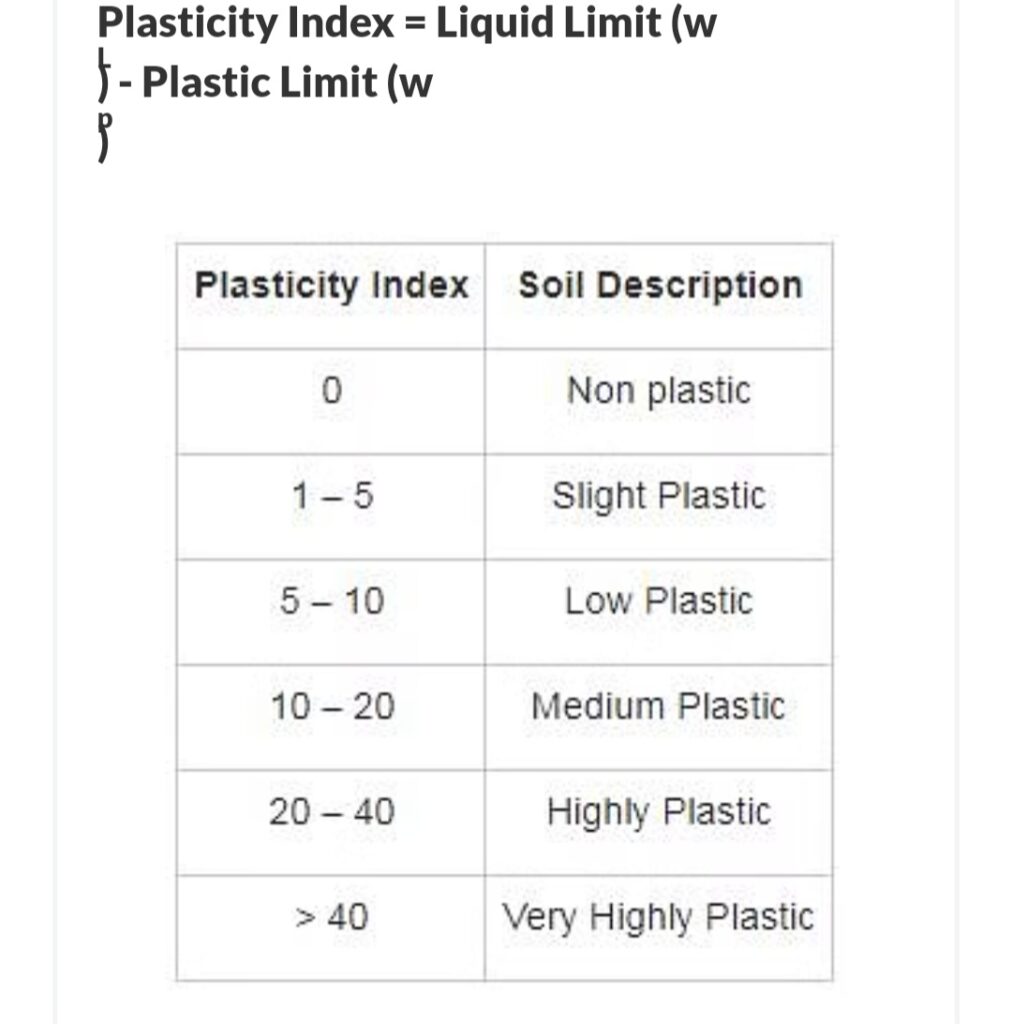
After determination of LL and PL, plasticity chart is then used to classify the soil.
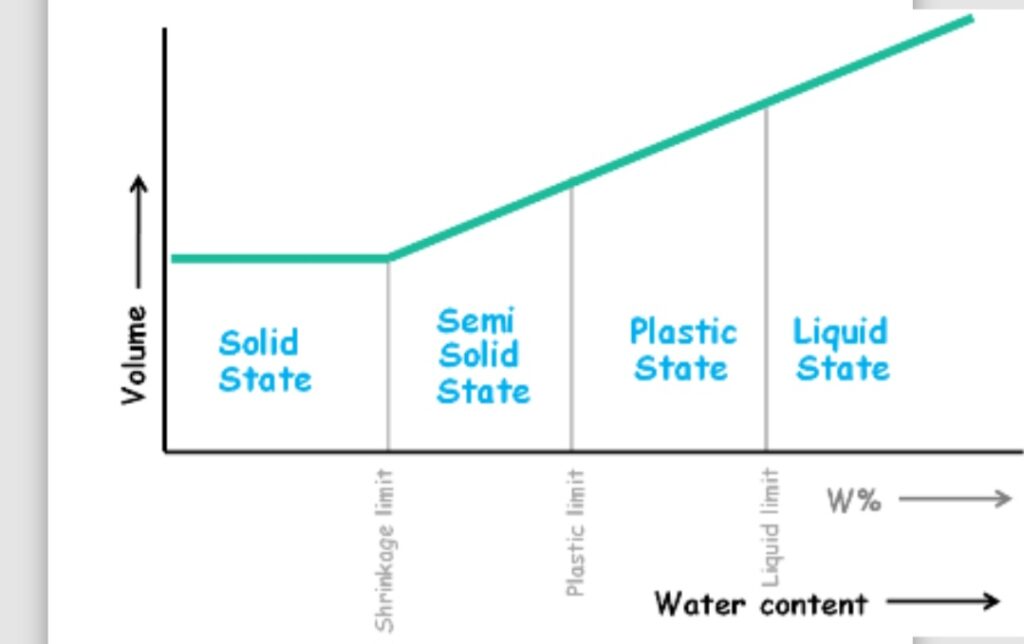
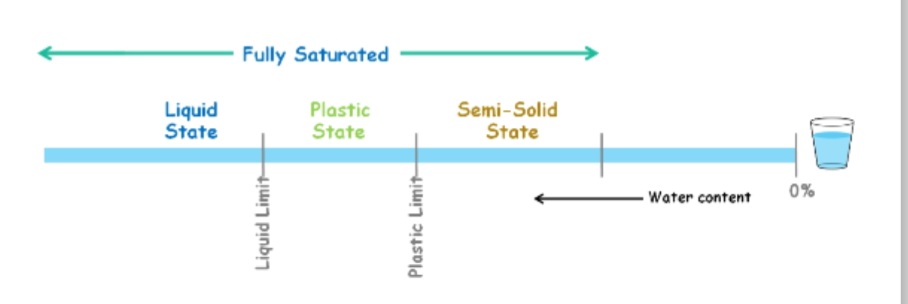
The knowledge of plastic limit and plasticity index is needed for the characterization of the shear strength, in terms of the normal stress applied and the water content of the soil.
c. SHRINKAGE LIMIT ( SL): This is the moisture content at which no further volume changes occur with further reduction in moisture content. It represent the amount of water required to fully saturate the soil. At this state, soils do not decrease their volume any more but continues to dry out. This state is needed to produce bricks and ceramics.

M1- Initial mass of soil in a saturated state
M2- Final mass of soil in a dry state
V1-Initial volume of soil in a saturated state
Vf- Final volume of soil in a dry state
Pw=1g/cm3
IMPORTANCE OF ATTERBERG’S LIMIT
1. The knowledge of soil consistency is important in defining or classifying a soil type or predicting a soil performance when using a construction material.
2. Atterberg’s limits are used to measure the physical condition of soil at different water contents.
3. Atterberg’s limits is an indices of workability of soil at various water contents. These depend on texture, organic matter content and amount of clay in the soil.
4. It is used to describe the consistency of fine -grained soils. This soil usually exist with its particles surrounded by water. The amount of this water determines the state or consistency of the soil.
5. Soil consistency is a practical and inexpensive way to distinguish between silt and clay.
6. Soils consistency is used to describe a soil profile and for estimating suitability for traffic and tillage.
Atterberg’s Limits of soil consistency is usually described at three soil moisture levels such as dry, moist and wet and terms used to describe the soil consistency are hard or harsh for dry soil, soft or friable for moist soil and plastic and sticky for wet soil. Plastic consistency is optimum condition for puddling.
OTHER TERMINOLOGIES USED IN LIMITS OF SOIL CONSISTENCY
Based on water content, other limits of soil consistency are briefly described thus:
FLOCCULATION LIMIT: Moisture content at which soil suspension is transformed from liquid state to a semi-liquid state with appreciable increase in viscosity.
LIQUID LIMIT
a. (upper plastic limit): Moisture content at which soil-water system changes from viscous fluid to a plastic body. Soil is near saturation, it behaves like softened butter.
b. Lower Plastic limit: Water content at which soil changes from a plastic to semi-rigid and friable state. Between upper and lower plastic limits, soil can be moulded into various shapes without breaking.
STICKY LIMIT: Minimum moisture content at which soil paste will adhere to a steel spatula drawn over its surface.
FRIABLE (SOFT) CONSISTENCY: The water content in this range permits easier crumbling of the soil. Friable consistency presents the optimum conditions for tillage, preparation of seed-bed and other agricultural operations. This is reached at moisture contents slightly less than lower plastic limit.
HARSH CONSISTENCY : Upon dehydration, soil becomes hard due to clay cementation and the consistency is called harsh. It requires more power to plough soil at this water content and soil becomes cloddy when ploughed.
In conclusion, Soil consistency may be estimated in the field using simple tests or may be measured more accurately in the laboratory.
